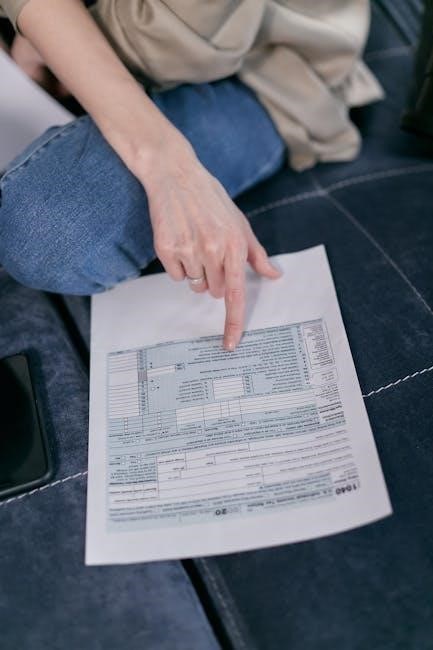Form DTF-95 is used by businesses to update their tax account information with the New York State Department of Taxation and Finance, ensuring accurate records and compliance.
1.1 Overview of DTF-95
Form DTF-95, or the Business Tax Account Update, is a document used by businesses to notify the New York State Department of Taxation and Finance of any changes to their tax account details. This form is essential for maintaining accurate records and ensuring compliance with state tax regulations. It allows businesses to report updates such as changes in business name, address, identification number, ownership details, or business structure. However, it does not cover entity changes or account closures. The form must be submitted separately for each tax type requiring updates. For address changes, businesses may alternatively use Form DTF-96. Proper completion and submission of DTF-95 help avoid discrepancies and ensure seamless tax reporting.
1.2 Purpose of DTF-95
The primary purpose of Form DTF-95 is to allow businesses to update their tax account information with the New York State Department of Taxation and Finance. This form ensures that the state maintains accurate and current records of business details, which is crucial for tax compliance and efficient communication. By submitting DTF-95, businesses can report changes such as updates to their business name, address, identification number, ownership structure, or contact information. This helps prevent errors in tax filings and ensures that the state can process tax-related matters smoothly. The form is not intended for entity changes or account closures, but it is essential for keeping business tax accounts up to date and accurate.
1.3 When to Use DTF-95
Form DTF-95 should be used whenever a business needs to update or correct its tax account information with the New York State Department of Taxation and Finance. Common scenarios include changes in business name, address, ownership structure, or identification number. Additionally, updates to telephone numbers, responsible persons, or business activity details also require submission of this form. Businesses must file DTF-95 separately for each tax type that requires updates, ensuring all changes are accurately reported. It is essential to submit the form promptly after any changes occur to maintain compliance and avoid potential issues with tax processing. This form is not suitable for entity changes or closing accounts, but it is vital for keeping business tax records current and accurate.

Eligibility Criteria
Businesses registered in New York State are eligible to file Form DTF-95 to update their tax account information. This includes corporations, partnerships, and sole proprietorships.
2.1 Businesses Eligible to File DTF-95
All businesses registered in New York State are eligible to file Form DTF-95 to update their tax account information. This includes corporations, partnerships, and sole proprietorships. The form is designed for entities needing to report changes such as business name, address, identification number, or ownership details. It is not limited to specific types of businesses but applies broadly to any entity with a tax account requiring updates. Businesses must complete a separate form for each tax type with unique updated information. If only reporting an address change, Form DTF-96 may be used instead. Eligibility extends to all registered businesses in New York State, ensuring accurate and up-to-date tax records.
2.2 Types of Businesses That Need to File
Various types of businesses in New York State are required to file Form DTF-95 to update their tax account information. Corporations, partnerships, sole proprietorships, and limited liability companies (LLCs) must submit this form when reporting changes. Businesses with multiple tax accounts, such as sales tax or withholding tax, must file separate forms for each affected account. Any entity registered with the New York State Department of Taxation and Finance that experiences changes in business name, address, ownership, or other details must file Form DTF-95. This ensures compliance and maintains accurate records with the state tax authority. All businesses, regardless of size or structure, must update their information promptly to avoid discrepancies.

Required Information
Form DTF-95 requires businesses to provide their name, address, identification number, ownership details, and contact information to update their tax account with the state accurately.
3.1 Business Name and Address
When completing Form DTF-95, businesses must provide their official name and current address. The business name should match the one registered with the New York State Department of Taxation and Finance. The address must be a physical or mailing address, including the street, city, state, and ZIP code. Ensure the address is up to date, as this information is used for tax correspondence and record-keeping. If the business operates from a PO box, additional details may be required. Accurate entry of this information is crucial for maintaining correct tax records and ensuring timely communication from the tax department. Double-check the business name and address for accuracy before submission to avoid delays or compliance issues.
3.2 Identification Number
When completing Form DTF-95, businesses must provide their unique identification number. This is typically the Business Identification Number (BIN) or Federal Employer Identification Number (FEIN). The identification number ensures accurate record-keeping and verifies the business’s identity with the New York State Department of Taxation and Finance. Enter the number exactly as it appears on official tax documents to avoid errors. Double-check the identification number for accuracy before submission, as any discrepancy could delay processing or lead to compliance issues. This step is crucial for maintaining proper tax records and ensuring timely updates to the business tax account.
3.3 Ownership Details
Form DTF-95 requires accurate ownership details to ensure proper updates to the business tax account. Provide the names, titles, and ownership percentages of all owners, officers, or responsible persons. For entities with complex structures, list affiliated persons if applicable. This information helps the New York State Department of Taxation and Finance maintain accurate records and verify the business’s tax obligations. Ensure all details are up-to-date, as changes in ownership or leadership may require updates. Incomplete or incorrect ownership information can lead to processing delays or compliance issues. Double-check all entries for accuracy before submission to avoid potential complications. This step is vital for maintaining compliance and ensuring seamless communication with tax authorities.

Filling Out the Form
Complete Form DTF-95 systematically, ensuring all business details are accurate and up-to-date. Follow the provided instructions carefully to avoid errors and ensure compliance with tax requirements.
4.1 Step 1: Accessing the Form
To begin, visit the official website of the New York State Department of Taxation and Finance. Navigate to the forms section and download the latest version of Form DTF-95. Ensure you select the correct year and version of the form, as it may be updated periodically. For convenience, you can also access the form through authorized tax software or online platforms like PDFfiller or SignNow, which offer fillable and editable versions. Once downloaded, review the form to familiarize yourself with its structure and requirements. Make sure to check for any specific instructions or updates on the Tax Department’s website to ensure compliance. This step is crucial for a smooth and accurate submission process.
4.2 Step 2: Filling in Business Details
Start by entering your business name exactly as it appears on your tax records. Provide the complete business address, including street, city, state, and ZIP code. Next, fill in your business identification number, which may be your Employer Identification Number (EIN) or other relevant tax ID. Ensure all details are accurate to avoid processing delays. Review each field carefully, as errors in business details can lead to issues with your tax account updates. Double-check for typos or mismatches with your previous submissions to maintain consistency. If you’re using online software, consider utilizing auto-fill options to streamline the process and reduce the chance of errors.
4.3 Step 3: Updating Ownership Information
Enter the current ownership details of your business, including the names, titles, and ownership percentages of all owners, officers, or responsible persons. Ensure the information is accurate and reflects any changes since the last filing. If there are new owners, provide their full legal names and ownership percentages. For deceased or former owners, indicate their removal and the effective date of the change. If ownership percentages have shifted, update them accordingly. Verify that all provided information matches official documents, such as Articles of Incorporation or Operating Agreements. If no ownership changes have occurred, you may leave this section blank or mark it as “no change.” Accuracy is crucial to avoid delays in processing your update.
4.4 Step 4: Reviewing the Form
Thoroughly review the completed DTF-95 form to ensure all information is accurate and complete. Check for any typographical errors, inconsistencies, or missing fields. Verify that the business name, address, identification number, and ownership details match your official records. Ensure that all updates are clearly stated and that no sections are left blank unless explicitly allowed; Review the instructions provided with the form to confirm compliance with formatting and content requirements. Make sure all numerical data, such as ownership percentages, is correct and adds up properly. If any changes were made, double-check that they are reflected accurately. This step is critical to preventing delays or rejection of your submission by the New York State Department of Taxation and Finance.
4.5 Step 5: Signing the Form
Once the form is reviewed and all information is confirmed to be accurate, the authorized individual must sign and date the form. The signature should be original and legible, accompanied by the signer’s title. Ensure the date reflects the day the form was signed. Unsigned forms will not be processed, so this step is crucial. Consult the official instructions for any specific signature requirements. After signing, make a copy for your records. The completed and signed form must then be mailed to the address provided in the instructions. Properly signing and dating the form ensures compliance and avoids delays in processing your business tax account update with the New York State Department of Taxation and Finance.

Submitting the Form
Submit the completed and signed Form DTF-95 by mail to the New York State Department of Taxation and Finance at the specified address provided in the instructions.
5.1 Submission Methods
Form DTF-95 can be submitted by mail to the New York State Department of Taxation and Finance at the address provided in the instructions. For address changes, online submission is available through the Tax Department’s website for eligible tax types. If online submission is not an option or for other updates, mail the completed form to the specified address. Ensure the form is signed and includes all required information to avoid delays. For address-only changes, Form DTF-96 may be used instead. Submitting via mail is the standard method for most updates, while online submission is the fastest option for address changes. Always verify the correct mailing address and submission guidelines in the official instructions before sending.
5.2 Processing Timeline
The processing timeline for Form DTF-95 varies depending on the submission method and the complexity of the updates. Online submissions for address changes are typically processed faster, often within a few days. Mailed forms may take 4-6 weeks for processing, while more complex updates, such as changes to business structure or ownership, may require additional time. It is recommended to allow up to 8-10 weeks for updates involving detailed reviews. Businesses should keep a copy of the submitted form for their records until confirmation of processing is received. Delays may occur during peak tax seasons, so it is advisable to submit updates well in advance of any critical deadlines. Always check the Tax Department’s website for the most current processing times.

After Submission
After submitting Form DTF-95, the Tax Department will review and process your updates. Businesses will receive confirmation once the changes are approved and implemented in their tax records.
6.1 What to Expect After Submission
After submitting Form DTF-95, the New York State Department of Taxation and Finance will review and process your business tax account updates. Businesses can expect to receive confirmation once the changes are approved and implemented in their tax records. The processing timeline may vary depending on the complexity of the updates. It is essential to retain a copy of the submitted form and any acknowledgment or confirmation received for your records. The Tax Department will update their systems accordingly, ensuring accurate tax account information. If no issues are found, the changes will be reflected in future tax communications. Businesses should monitor their accounts for any further requests or notifications from the department.

Alternative Method for Address Changes
Use Form DTF-96 for reporting only address changes, offering a faster and more straightforward method when online submission isn’t available or preferred.
7.1 Using Form DTF-96
Form DTF-96 is specifically designed for reporting address changes for business tax accounts. It provides a streamlined process for updating physical business locations efficiently. Businesses can use this form when they need to correct or change their address without making other updates. DTF-96 is particularly useful when online submission isn’t an option or when only the address needs modification. It ensures that the New York State Department of Taxation and Finance has the most current business address on file, which is crucial for tax correspondence and compliance. By utilizing DTF-96, businesses can avoid the broader updates required by Form DTF-95, making it a convenient alternative for address changes alone.

Common Mistakes to Avoid
Common mistakes include using incorrect forms for address changes and providing inaccurate business details. Ensure to use DTF-96 for address updates and verify all information for accuracy.
8.1 Errors in Business Details
Errors in business details are a common issue when filing Form DTF-95. Incorrect business names, addresses, or identification numbers can lead to processing delays or rejection of the form. It is crucial to double-check all information before submission. Ensure the business name matches official records, and the address is up-to-date. Additionally, verify the identification number, such as the EIN or other tax-specific identifiers, for accuracy. Providing outdated or incorrect information may result in compliance issues or additional requests for documentation. Always review the form thoroughly to avoid such mistakes and ensure smooth processing of your business tax account updates with the New York State Department of Taxation and Finance.

Troubleshooting
For issues with Form DTF-95, contact the Business Tax Information Center or visit the official website for guidance. Ensure all details are accurate to avoid delays or rejection.
9.1 Resolving Common Issues
Common issues with Form DTF-95 often arise from errors in business details or incomplete submissions. Verify that all fields, such as business name, address, and identification number, are accurate and up-to-date;
If you encounter processing delays, check for missing signatures or outdated form versions. Ensure the form is signed by an authorized representative and submitted to the correct address.
For technical difficulties, visit the official New York State Department of Taxation and Finance website or contact their support team for assistance. Addressing issues promptly ensures timely updates to your business tax account.

Additional Resources
Visit the official New York State Department of Taxation and Finance website for form instructions, FAQs, and contact information to assist with DTF-95 submissions.
10.1 Where to Find Help
For assistance with Form DTF-95, visit the official New York State Department of Taxation and Finance website. The site offers detailed instructions, downloadable forms, and FAQs. Additionally, you can contact the Business Tax Information Center for guidance. Technical support is available at 1-800-431-9025, option 4. The website also provides options to submit questions online or access e-forms for address changes and other updates. For further assistance, refer to Form DTF-95-I, which includes step-by-step instructions and troubleshooting tips. Ensure you use the latest version of the form for accurate submission;
Form DTF-95 is a crucial tool for businesses in New York to maintain accurate tax records with the Department of Taxation and Finance. By following the instructions and submitting the form correctly, businesses ensure compliance with state tax requirements. Regular updates help avoid discrepancies and potential issues. Always refer to the official website for the latest versions and guidelines. If unsure, consult the provided resources or contact support for assistance. Accurate and timely submissions are essential for smooth tax operations. Ensure all details are double-checked before filing to avoid delays. Staying informed and adhering to tax obligations is vital for business continuity and legal compliance.
